 |
|||||||||||||
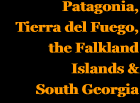 |
|||||||||||||
 |
|||||||||||||
 |
|||||||||||||
Main pages
Appendices
4 Pichi-Ropulli Osorno report •
9 Branchline station photos 2 •
11 Barros Jarpa Noel agreement ª
Chapter 5
The south end of the Chilean broad gauge


Locomotives and rolling stock
Chilean broad gauge steam locos
On the formation of the Ferrocarriles del Estado de Chile (the EFE) in 1884, the loco fleet began with those inherited from the three predecessor railways, the FCSV, FC del Sur and FCCCiT. These were largely 4-4-0s and 2-6-0s and the majority of EFE orders until the end of the 19th century were of similar types, though with a clear division between the British manufacturers preferred by the Santiago to Valparaiso engineers, and the Baldwin and Rogers products favoured by the management further south (1).
An FC Santiago a Valparaiso 0-4-2 passenger loco built by Hawthorn in 1855.
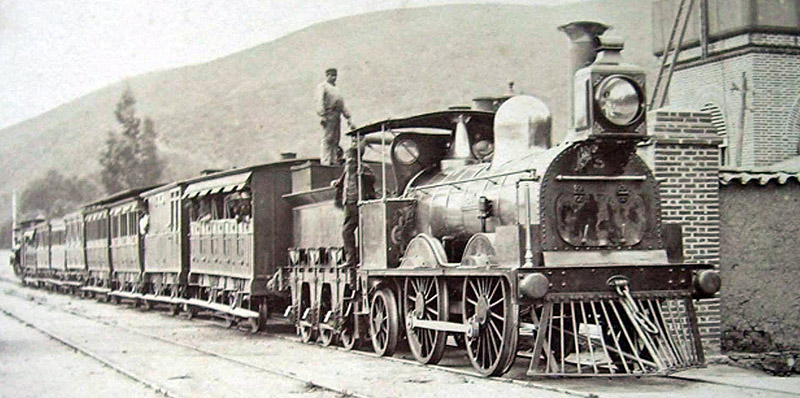
FCSV no. 23 was one of a batch of twelve 4-4-0s built by Hawthorn in 1868.
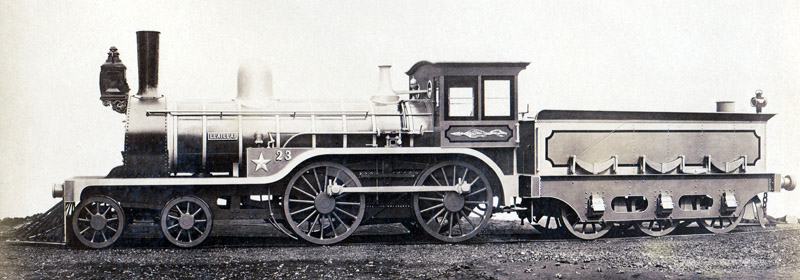
One of nine 4-4-0s built for the EFE in 1889 by Dübs of Glasgow. These later became tipo 36.
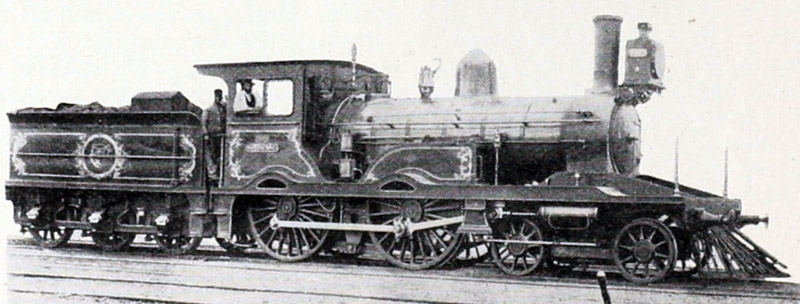
FC del Sur no. 5 ‘SAN BERNARDO’ was built by Rogers in 1856.
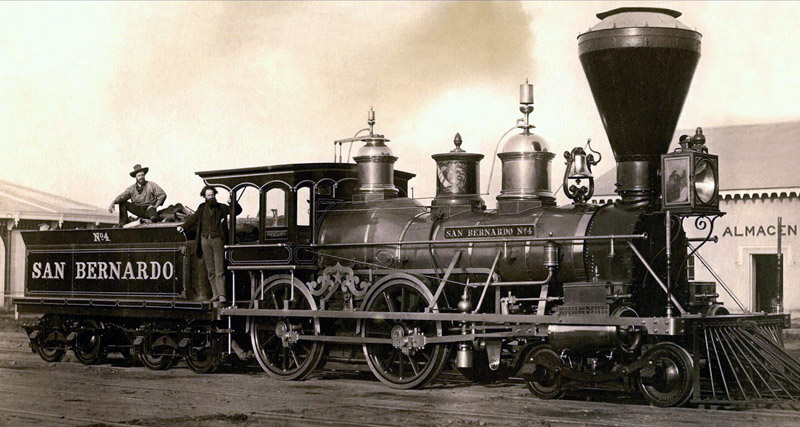
No. 18 ‘TALCA’ was a Rogers 2-6-0 built for the FC del Sur by Rogers in 1874.
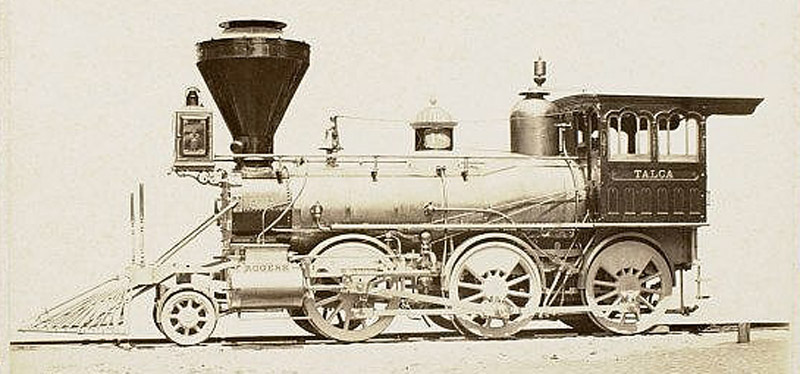
FC del Sur no. 7 ‘MAPOCHO’ was a 4-4-0T built by Rogers in 1860.
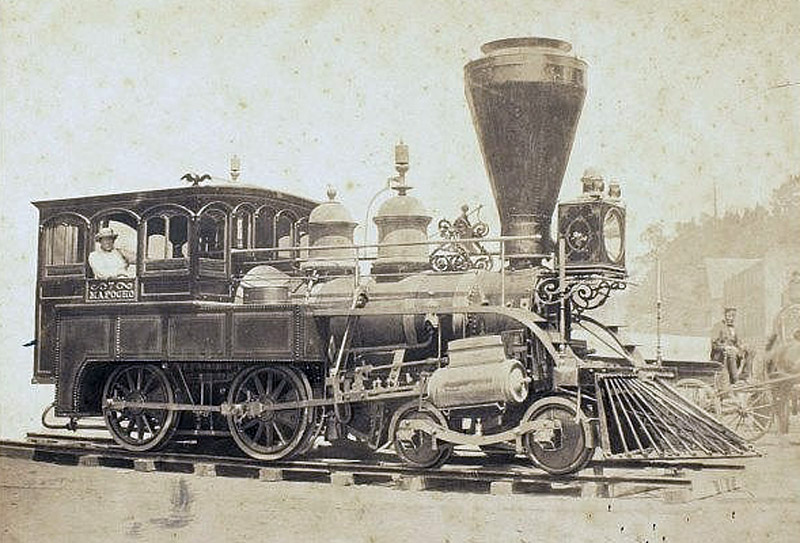
This, however, gives no indication of the problems that are involved in analysing the early Chilean broad gauge loco list. In the years before 1900, the EFE operated perhaps 300 locomotives, but of at least 55 different varieties (2).
Additional locos were also built up from spare parts at the railways’ own shops in Santiago, Valparaiso or Concepción and then confusingly given the numbers of withdrawn engines. This was aided by a limited commonality in dimensions. For example, more than half of those 300 engines mentioned above had a common piston stroke of 24 inches, and therefore – in theory at least – their cylinders could be paired with any of the consequent large variety of wheels having a crank throw of 12 inches. Allen Copeland has reported that at least one loco was built from parts in the absence of any drawings, the motion being drawn out at full size on the workshop floor! (3)
The Chilean state-owned railways had embarked on fitting all locos and stock with Westinghouse air brakes from an early date. The air pump eventually used as standard was the Westinghouse 9½" size, as seen here.
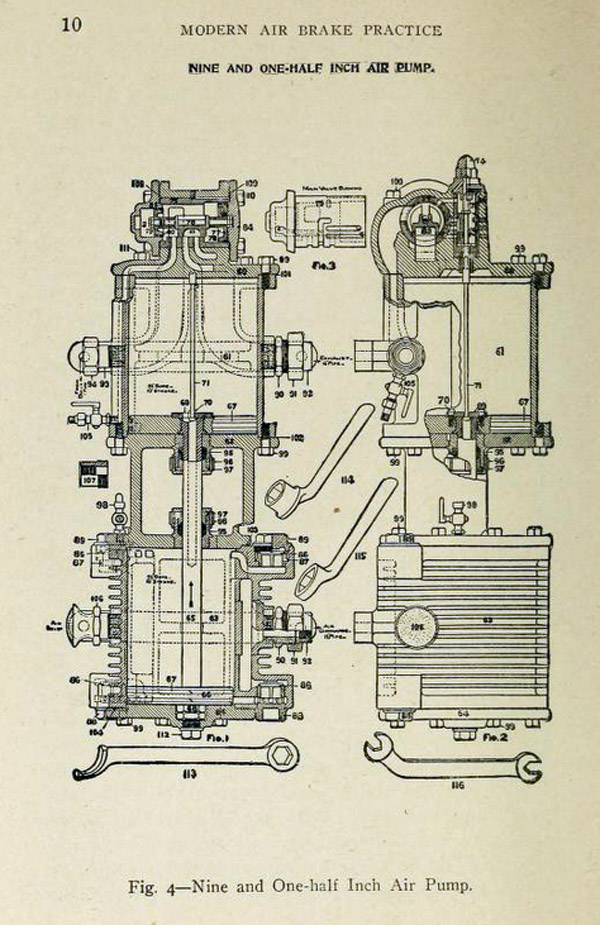
At the beginning of the 20th century this ad hoc construction of new locos, and the lack of class standardisation, was severely criticised by the responsible ministry (4). The problems, principally of a lack of common fittings which could be held in stock and of the resulting delays and increased costs in repairs and overhauls, were very obvious.
The tipo 38 heavy freight 4-6-0s were built by Rogers in 1893 and then by the EFE's own Santiago workshops in 1894. No. 211 survives in the Quinta Normal museum.
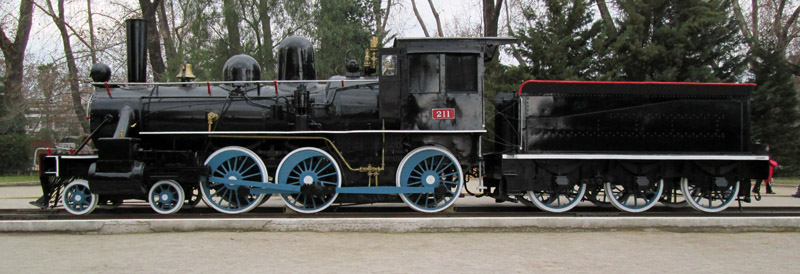
From then on more modern locos began to appear, including a batch of 0-6-0 goods engines (tipo 47) which would have looked quite at home in Britain, though in fact they were the product of a close relationship for a while between the EFE and the German manufacturer Borsig. In 1903 came the first of what was to be Chile’s largest class, the tipo 57 2-6-0s otherwise known as the North British de Carga or North British Goods. At least 114 of these were built over the following 14 years, not merely by NBL, but also by Henschel in Germany and by Chile’s own manufacturers, Balfour Lyon and the Sociedad Maestranza i Galvanizaciones in Caleta Abarca near Viña del Mar.
A tipo 47 Borsig 0-6-0, now residing in the museum at the Quinta Normal park in Santiago.
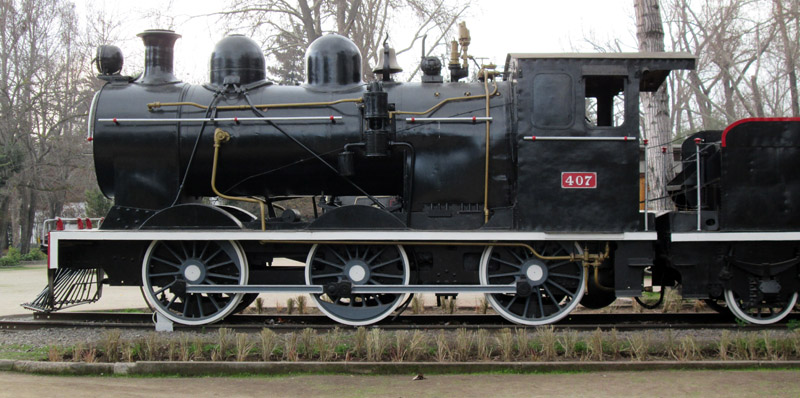
A tipo 57 North British de Carga’ 2-6-0, though actually built in this case by Lever Murphy in Chile.
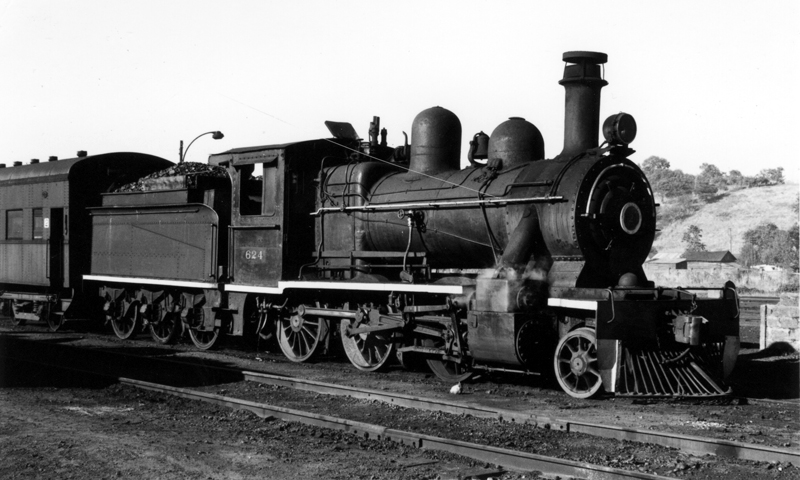
A tipo 58 4-6-0, designed by North British, but in the case of the second batch built by Hanomag in Germany.
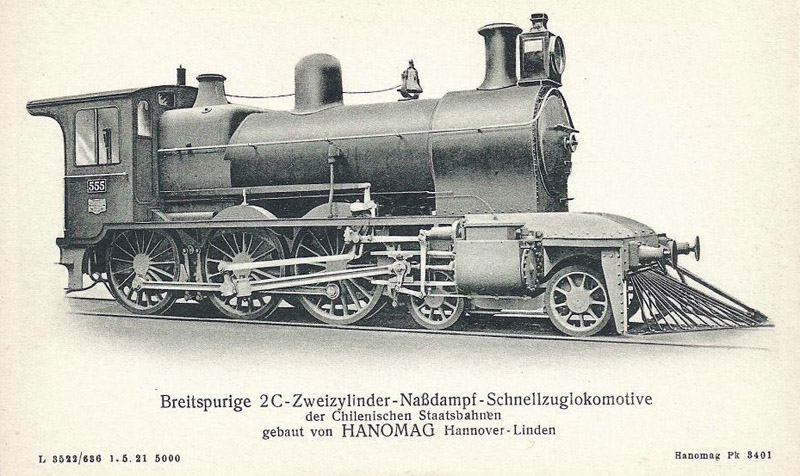
A variety of 4-6-0s were then followed in 1919 by the first of the type 70 2-8-2s. By this time the EFE numbering system had become rather more logical and both they and the later and larger types 80, 90, 100 and 110 bore running numbers starting with the class designation. For example the 70s were numbered from 701 to 753, whilst the huge mechanically-stoked type 100 4-8-4s were 1001 to 1010.
A tipo 70 ‘Mikado’ 2-8-2, as introduced in 1919. and built by Montreal Loco Works and ALCo's Schenectady works.
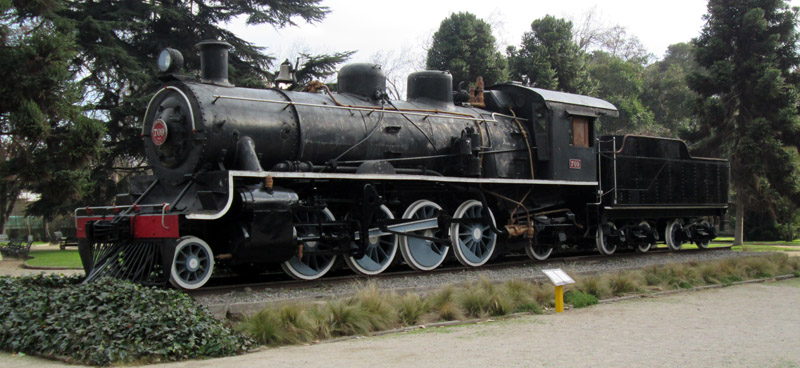
Las tipo 80 were 4-8-2s purchased initially in 1929 from Baldwin, 39 of them and with another 30 coming from Mitsubishi in 1952-3. These are the largest locos that we need to concern ourselves with, for the later machines, types 90, 100 and 110, worked only further north. The southern branches and even the southernmost end of the Red Sur mainline tended to be given the older and lighter machines in the manner of peripheral operations everywhere. In any case the largest classes had relatively short lives as their regular routes were the first to be electrified and they could not easily be cascaded down to more lightly laid lines.
The tipo 100 4-8-4s were constructed by Henschel und Sohn in 1936. Here the first locos arrive with some fanfare.
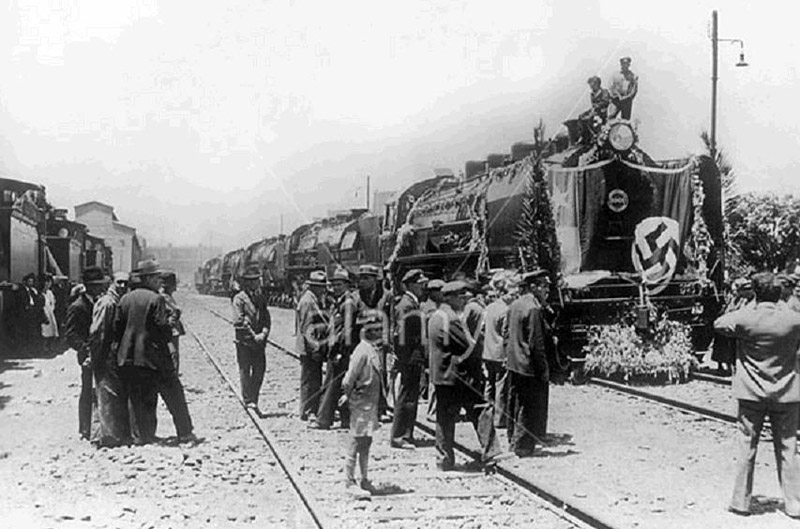
Whilst the argument about whether to follow British or American practice was not immediately resolved back in the 1880s, in fact designs from then on had tended to move towards American standards though locomotives continued to be supplied by builders outside the USA. Air brakes became the norm, and after the First World War the whole broad gauge system changed from using European-style side buffers and chain couplings to the American Sharon (aka Janney, MCB, Alliance, or now AAR) centre auto-coupler.
Coal was the principal fuel on the broad gauge, though in the early years wood had been a practical alternative in the forested southern areas. A number of local mines produced coal which, though sub-bituminous, was used extensively by the railways; for example, at Máfil, Pupunaque east of Antilhue, and several other locations southward to Osorno. As Ian Thomson has commented “Chilean coal declines from indifferent to worse as one travels south…”(5), and the many photos showing locomotives belching thick clouds of black smoke tend to reinforce this. Experiments with the burning of pulverized coal took place in the 1920s on examples of types 70 and 57, but do not seem to have been extended (6).
Locomotive types used on the southern lines
Of the 78 types of locomotive listed in the table on page 111, more than 60% first ran before 1900, ie. before any of the southern broad gauge lines covered in this chapter had been accepted into the EFE network. Whilst that adds force to the statement made earlier about the EFE’s original lack of standardisation, it makes our task here a good deal simpler, for the vast majority of those classes never made it south of Temuco.
As we have learnt, the first broad gauge sections to be constructed in our area were the two halves of the Valdivia to Osorno railway, and Table 5.1 on page 104 has already shown us that the DOP’s hire locos on those contracts were largely made up of two groups, Baldwin 4-4-0s of the type sometimes designated Peñaflor, and Rogers 2-6-0s. In theory at least, 4-4-0s in Chile were regarded as passenger engines whereas the 2-6-0s were supposedly for freight, but clearly these DOP hire locos had to turn their wheels to anything and everything. The 4-4-0s, interestingly, had not been EFE public service machines at all. Though almost identical to engines supplied to two of the pre-1884 independent companies in the early ’70s, this 1889 batch had been ordered by the ill-fated North & South American Construction Company of New York (7). On the demise of that enterprise they had been taken over by the DOP, and hired out to various contractors.
Those unlucky enough to get sent to either part of the Valdivia-Osorno construction work were clearly run absolutely into the ground, as the quote beneath the title of the chapter makes clear. Well worn by the time that public services began, the railway’s isolation from the rest of the network meant that they were kept in service, despite all the protests from local managers, until the Antilhue link northward was completed in 1907. At that point they were rapidly replaced, for by 1910 the fleet allocation to the 4a Sección or Zona – south of Victoria – comprised solely a batch of brand new Baldwin 2-6-0s (Nos. 467-86, later to become tipo 55), and three Baldwin 0-6-0Ts also new (Nos. 487-9, tipo 56). In fact the original engines may never have run again, for by then the older types were being withdrawn wholesale and all the classes numbered below 20 were extinct by 1922.
However, this simple situation did not last long, for from 1919 onward the arrival of 53 new type 70 Mikado 2-8-2s for Zones 1 and 2 had led to a cascading southward of earlier designs. In 1922 the locos running in Zone 4 included 18 newish tipo 20 4-4-0s built in Chile from 1909 onward, half a dozen old Baldwin 2-6-0s of tipo 21, a pair of Lima 2-6-2STs of tipo 34, and no less than 29 machines of tipo 57. The type 55 2-6-0s had disappeared northward to Zone 2, though there were now five of the type 56 0-6-0Ts in the area.
Further movement occurred later in the ’20s after electrification in Zone 1, and still more in the 1950s as dieselisation took place on the more important routes. The principal steam classes operating in the south latterly included:
Tipo 57 2-6-0s. This was Chile’s most numerous class of steam loco, there eventually being 114 or more (8). The first batch were built by the North British Locomotive Co. in 1903, hence their common class-name as las North British de carga, though in fact they were mixed traffic machines rather than purely goods locos.
A pair were rebuilt to a 2-6-2 wheel arrangement (tipo 57R) to take a boiler with a larger firebox, but once piston valves and superheating had been tried out successfully on No. 530 and then introduced to the rest of the class further rebuildings of this kind were considered uneconomic (23). All of the 57s were in due course upgraded.
The second Henschel batch, Nos. 580-5, were to be allocated to the new Puerto Montt extension on their arrival from Germany in 1913, though whether this actually happened is uncertain (24). As larger locos took over nearer to the capital, so more of them gradually moved to the south, and they eventually became the archetypal Chilean branch-line loco, only being withdrawn after the wholesale closure of secondary routes in the early 1980s. Interestingly, the Chilean habits of reusing vacant numbers and of creating extra locos from spare parts mean that the precise number built is not absolutely certain!
Tipo 47 0-6-0s. These were built by Borsig in Germany for goods train service during the short period around 1905-7 when that company, for whatever reason, won almost all the EFE’s loco contracts. The relatively high axle loading and the lack of a leading truck led to substantial front flange wear, and a transfer of a number to heavy shunting duties. Some did, however, survive until the end of steam, though those at Osorno in the late 1960s had gone by 1977.
Tipo 58 4-6-0s. These were similar in layout to the 57s, but slightly larger and with a leading bogie, thus being capable of higher speeds. There were just 25 of them, built by North British and Hanomag between 1908 and 1915.
Tipo 70 2-8-2s. Although the largest steam locomotives in Chile on their arrival, they were rapidly displaced by the later classes 80, 90, 100 and 110, and by electrification. Thus they could be found right down to Puerto Montt on the mainline, though less commonly on the branches for some of which they were too heavy. The whole batch had been built by Montreal Loco Works and their parent company ALCo between 1919 and 1925, and a number survived until the very end of steam operation.
Tipo 80 4-8-2s. These 163 tonne machines could be seen on both passenger and goods services on the mainline as far south as Osorno, though not beyond that point owing to axle loading considerations. As the list on page 128 proves, they could also work to Valdivia.
Museum pieces within the area
Several ex mainline steam locomotives are displayed on plinths in Osorno and Puerto Montt. At the former station tipo 54 0-6-0T No. 462, built by Hanomag in 1908, is displayed, whilst on the waterfront in Puerto Montt stand type 57 2-6-0 No. 606, and type 55 2-6-0 No. 478, the latter nicknamed ‘QUEPE’ after the first locomotive into Puerto Montt a century earlier.
A steam heritage train, El Valdiviano, has operated for some years from Valdivia to Antilhue at weekends, latterly using type 57 2-6-0 No. 620. The train has been supported by the Valdivia municipality, but there have been occasional worries about the long-term future which is dependent upon the state of the track, upon urban development not restricting operations, and on the continued good health of loco 620. Type 56 Baldwin 0-6-0T has also lain at Valdivia station in a derelict state, and whilst work is in progress towards its restoration to working order, one might wonder about its haulage capabilities.
During 2013 this operation came up against a dispute between the EFE and the city of Valdivia which has resulted in the access road to new development on railway land cutting straight across the platform roads at the north end of the station. Train movements were impossible until an agreement was reached, though they seem to have restarted by the end of that year.
Tipo 80 4-8-2 No. 820 has also ventured south from its Temuco base on occasions with excursion trains as a variation from the normal El Araucano itinerary.
Locomotive lists
An appendix page contains links to PDF files listing every known Chilean steam locomotive, with details if available.
Sources
1 Using Allen Copeland’s loco lists, the FC Valparaiso–Santiago purchased 98% of their overseas locos from the UK, whilst the southern lines obtained 94% of theirs from the USA. Locally-built engines have not been included in these figures.
2 Figures derived from study of locomotive lists.
3 This seems to have been No. 316 ‘JORGE BRUNTON’ of 1903.
4 Memorias anuales del Ministerio de Industria i Obras Públicas, 1901, 1902 p181, and 1903 p227-8.
5 Ian Thomson, 2001, North British de Carga; Chile’s most numerous locomotives, in En Tren issue No. 9, published by the ACCPF, Nov. 2001, and in English in Locomotives International, issue No. 61, Feb. 2002, pp2-8.
6 Memoria anual del Director General de los FFCC del Estado, 1921, p186-7.
7 The design was similar to the Curico & Angol railway locos of 1874, and Chillán, Concepción & Talcahuano railway locos of the same year.
8 Allen Copeland suggests that several extra locos of this type were assembled in EFE workshops from spare parts.
14-3-2018